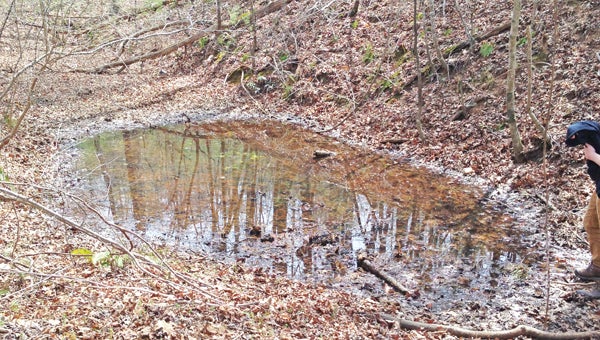Polk County’s most wanted habitat – vernal pools
Published 10:25 pm Monday, January 6, 2014

A vernal pool (photo by David Campbell)
In a joint effort to expand the knowledge and understanding of the flora and fauna of Polk County, the Pacolet Area Conservancy (PAC) and botanist, David Campbell, need your help in locating this month’s “Most Wanted-Habitat,” vernal pools.
Many have seen vernal pools but may not have realized their great importance to wildlife and ecosystems as a whole. As the name implies, vernal pools are habitats strongly correlated with the spring (“vernal” is from the Latin word for spring, such as “Vernal” Equinox).
In our region, vernal pools actually tend to form in late winter and early spring, depending on weather conditions and the amount of rainfall.
Vernal pools are seasonal and temporary, typically occurring within the lower areas of mixed hardwood forests. Because of their temporary nature, vernal pools are not inhabited by fish, which is an important reason that these small water bodies are used as breeding sites for many species of amphibians, notably salamanders. The absence of fish allows for much lower levels of predation on larval amphibians.
The reproductive ecology of amphibians that use these pools is timed to coincide with late winter and early spring rains, and their larval stages will complete their life cycle rapidly, before the pools dry up by late spring.
One species of salamander, rare in our region, is the Mole Salamander (Ambystoma talpoideum). The Mole Salamander, as its name suggests, spends most of its life underground. However, the Mole Salamander must utilize temporary pools in woodlands in order to breed.
Breeding may occur in autumn, or spring, often depending on rain and temperature. Mole Salamanders are known to occur in Polk County, but are rare here. Another species that utilizes vernal pools for breeding in our area is the Spotted Salamander (Ambystoma maculatum). The Spotted Salamander is known to many as a large black salamander with the yellow polka dots and is deservedly regarded as a beautiful species.
Threats to vernal pools include construction, land clearance for agricultural crops, as well as the conversion of native hardwood forests to pine plantations. If you are fortunate enough to have such temporary wetlands on your property, keep an eye out for some of our lesser known woodland denizens that are an integral component of our forests.
If you think that you have vernal pools that may be important sites for amphibian reproduction or if you know where vernal pools might be located, please contact PAC at 828-859-5060, or e-mail comments, questions or photos to landprotection@pacolet.org. PAC is interested in documenting the occurrence of vernal pools in Polk County.
– article submitted
by Pam Torlina





